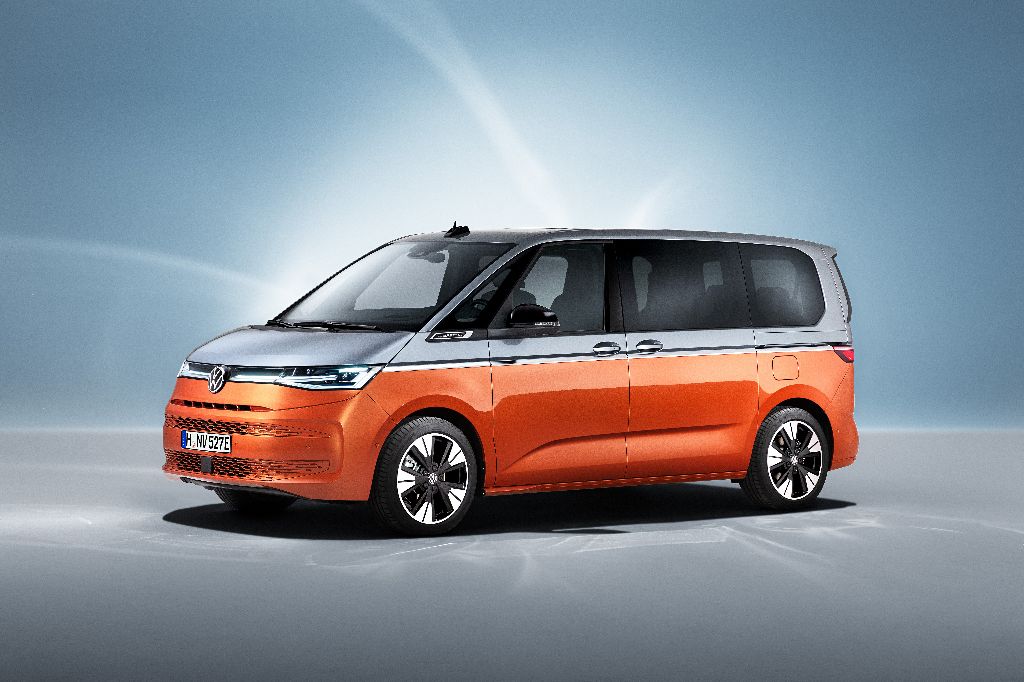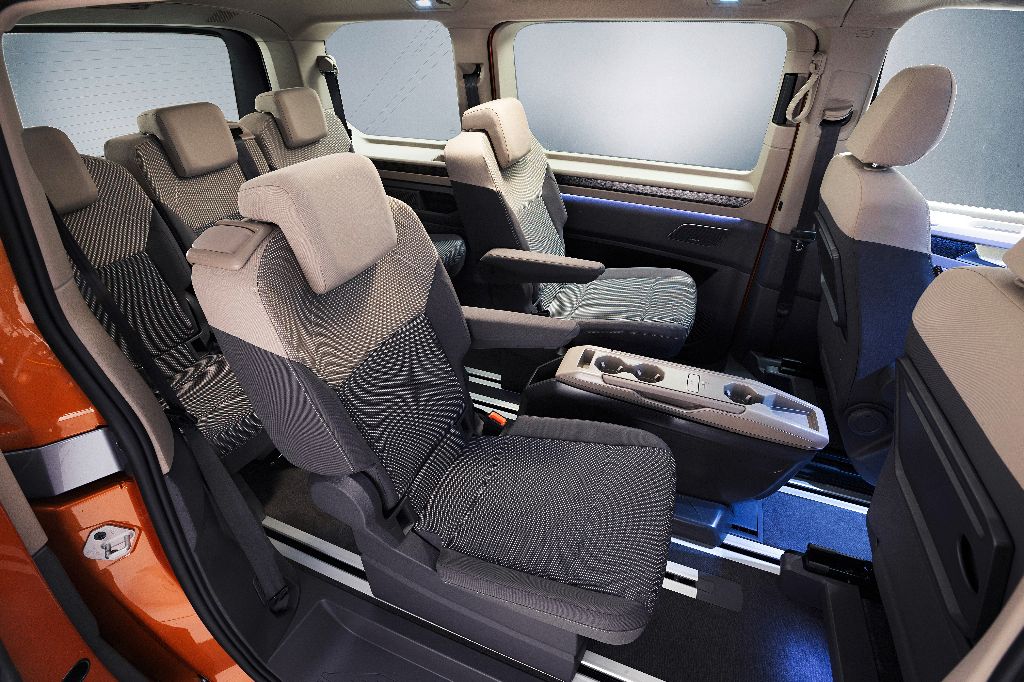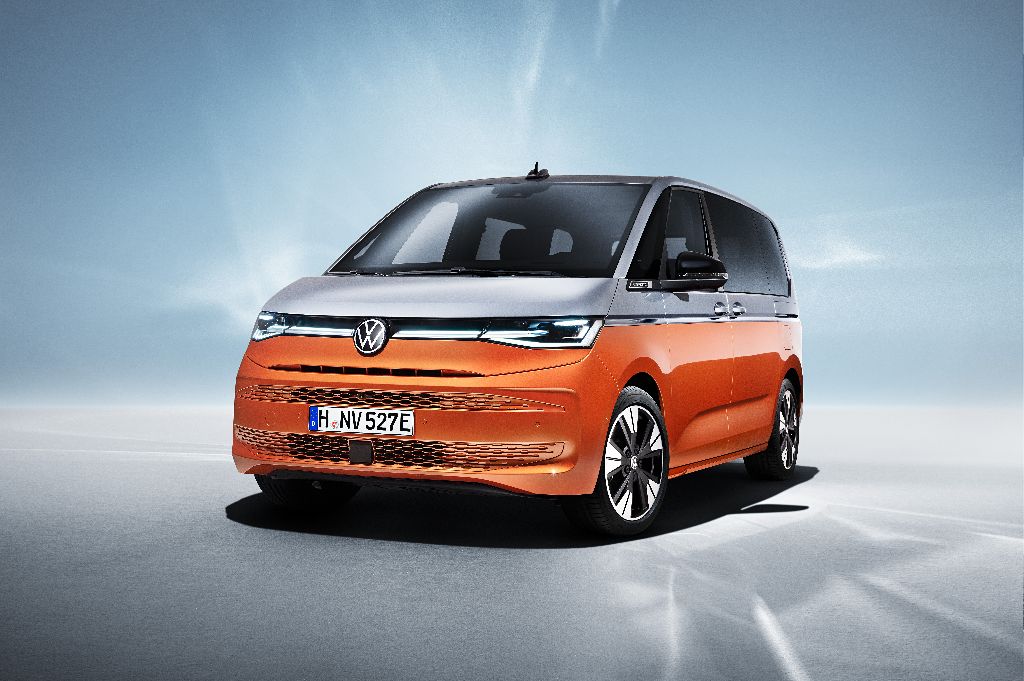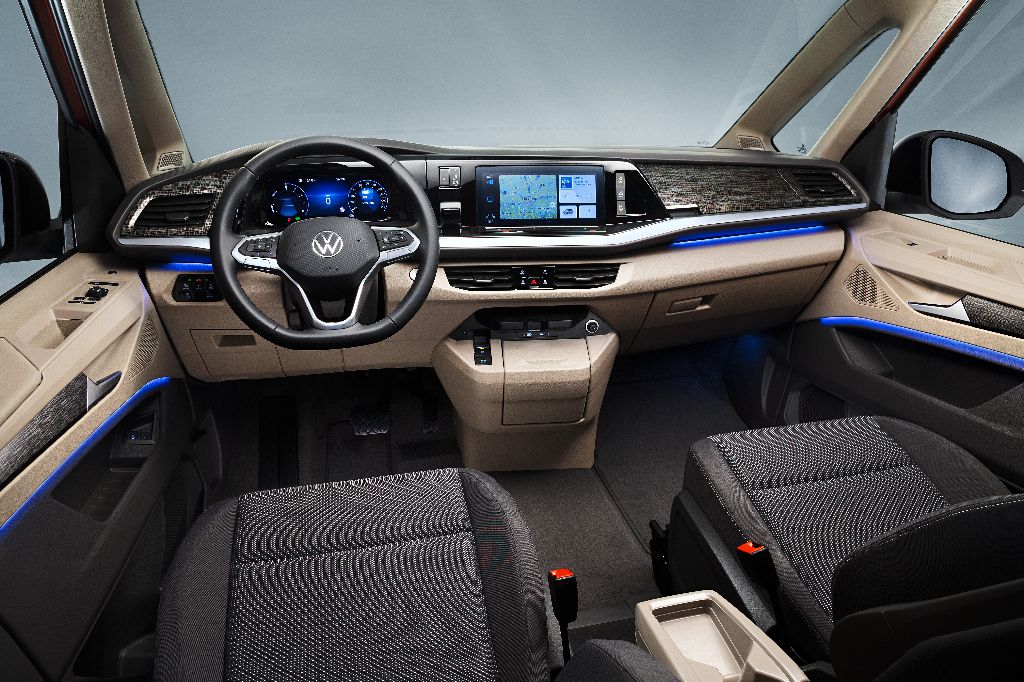Home »
It's been 70 years since the Volkswagen Transporter first arrived in the UK, making it's public debut at the Commercial Motor Show at Earl's Court, in 1954.
Six generations later, the Transporter is now about to get its seventh generation when it is revealed at the IAA Hannover trade show in September. The newest version will share a platform with the Ford Transit Custom - the first time the VW Transporter has paired up with a partner.
It will get distinctive Volkswagen styling on the inside and out, but will share the same range of engines inlcuding plug-in hybrid and a full battery electric vehicle version.
Since first arriving, the Transporter has sold more than 13 million units across the world and has grown from just 786 UK sales in 1954, to a whopping 17,521 in 2023.
The most recent update was to the Volkswagen Transporter T6.1, launched in 2019, which got a new dashboard, improved connectivity and under went a facelift with updated headlights and grille.
Here's a brief history of the rest of the VW Transporter range.
T1: 1950 to 1967
Revealed as a hand-built panel van prototype in 1949, the T1 eventually launched as a rear-engine panel van, passenger van and eight-seat vehicle. The engine and gearbox came from the Volkswagen Beetle and it offered a maximum payload of 750kg. In 1951, the iconic "Samba" model was revealed with all-round windows and folding sunroof, and a year later a pick-up version was unveiled. Production moved from Wolfsburg to Hanover in 1956, with some models built in Brazil. By 1967, around 1.9 million people had purchased the T1 with its "splittie" windscreen, making it a global success.
T2: 1967 to 1979
With the T1 forging its name as something of a cultural icon during the swinging sixties era, the successor had a lot to live up to. The T2 took the design and utility of the van forward with a new front end and air intake grille. A sliding door was now standard, and the pop-up roof camper version became an instant hit with globetrotters. In 1972, the T2 went electric with a zero-emission version available to buy. During its run, 2.14 million vehicles were built at the Hanover plant. Production continued until 2013 at the Volkswagen plant in Sao Paulo.
T3: 1979 to 1992
The T3 took the famous vehicle into the modern era with a wider body offering, more passenger and cargo space and improved safety. A flat engine, available in diesel, was introduced adding to the spaciousness while a new chassis offered car-like handling. In 1985, a raft of innovations were added: catalytic converters, turbochargers and all-wheel drive, while the California and Caravelle became popular. In total, 1.3 million T3s were made in Hanover.
T4: 1990 to 2003
This generation marked a technical revolution with Volkswagen Commercial Vehicles making the T4 front-engine and front-wheel drive for the first time. With this came a new design, longer front end, new suspension, more varied engine choice and even better handling. The Transporter was also available in two wheelbases for the first time. Following a 1996 mid-model refresh, the T4 was phased out in 2003 having sold 1.9 million models across the range, which had grown to feature the panel van, kombi, double cab, pickup and chassis with single and double cab, Caravelle, Multivan and California.
T5: 2003 to 2015
The T5 was an evolution of exterior design with greater focus placed on the interior and the driver's workplace as well as a variety of petrol and diesel engines and an all-wheel drive system. The California was built in Hanover for the first time, while Caravelle and Multivan continued to be popular choices alongside a number of limited-edition models. In total, 1.65 million T5s were produced.
T6 / T6.1: 2015 to 2019 / 2019 to present
New engines, intelligent driver assistance systems, new infotainment and a front-end redesign have defined the modern T6 era - while the two-tone paint scheme serves as a nod to the original model. In 2019, Volkswagen Commercial Vehicles brought the iconic van into the digital age with a new dashboard design, a raft of technology and connectivity updates as well as a new power steering system and additional efficient, clean turbodiesels.
The first proper details of the upcoming Volkswagen Transporter have been released ahead of its reveal at the IAA Hannover commercial vehicle trade show in September.
The digital renderings released by Volkswagen Commercial Vehicles show minor details of the what will be the seventh-generation Transporter including the headlight and rear light design as well as alloy wheels and the PanAmericana name currently used on high trim level Volkswagen Amarok pick-up trucks.

Accompanying two official graphics of the alloy wheel design and PanAmericana name badge is a short video where viewers get a glimpse of the new headlights and electric vehicle charging point, and the rear light cluster.
The new model will be made by Ford and is based on the Ford Transit Custom and Ford E-Transit Custom but VW says the new Transporter “seamlessly follows the classic Bulli DNA” adding that they have “systematically enhanced the design – as is perfectly demonstrated by the new PanAmericana”.
“The new Transporter combines a high degree of utility with the distinctively clean and iconic style of Volkswagen Design. It is not just the vehicle’s overall lines, but also its individual elements that have become hallmark features of the product line,” says says Albert Kirzinger, Volkswagen Commercial Vehicles’ chief designer.

For the first time in the history of the Transporter, the PanAmericana will be launched with 19-inch wheels as standard. It will get a diamond-cut rim and black spoked star – a nod to the Indianapolis wheel recognisable as a Transporter design.
“The headlights and tail light clusters have long been more than just sources of light. Even the first Transporter had round headlights that made it look like the commercial vehicle had eyes, giving the front end a face. The new Transporter also has an unmistakable face – and this is once again thanks to its striking light design,” Kirzinger adds.
PanAmericana trim will also include the top-spec version of the new LED headlights, however, even the entry-level new Transporter vans will also have LED headlights.
Watch the video of the new Volkswagen Transporter PanAmericana teaser below.
Rising inflation, unstable supply chains and the war in Ukraine all contributed to a challenging year for Volkswagen Nutzfahrzeuge (Volkswagen Commercial Vehicles) according CEO and Chairman of the Board of Management, Carsten Intra. Despite these pressures, however, the German van manufacturer still managed to achieve earnings of more than half a billion euros for the second year in a row.
At the end of the 2022 financial year VW recorded an operating profit of €529m, even though vehicle deliveries dropped slightly. Sales increased to €11.5bn compared to €9.9bn in the previous year thanks to the success of the Volkswagen ID Buzz and Volkswagen ID Buzz Cargo. Although Intra says that sales of pure BEVs are still at a low level, he believes this should rise quickly.
Global vehicle deliveries by Volkswagen Commercial Vehicles fell from 359,500 to 328,600 units but crucially their market share improved in some of the most important regions. Its performance in Europe saw a 1.5% increase to almost 13% and according to its own statements, VWCV achieved an improved market share of more than 23% in its home market of Germany.
Although 2022 was the year VW re-entered the pick-up truck segment with the new Ford-manufactured Amarok, based on the Ford Ranger, it was very much a year for EVs, with a total of 7,500 all-electric vehicles delivered to customers – more than twice the number of electric vehicles registered in the previous year. Volkswagen’s electric commercial vehicles are, however, still only making up a fraction of total market sales in Europe at just 2.3% of the overall segment.
Yet, the demand for Volkswagen vans also led to record levels for their order book with nearly 300,000 vehicles on order. The Hanover plant, previously used to produce Volkswagen Amarok pick-ups but now producing the ID Buzz should reach full capacity during this year, producing 900 vehicles a day to help clear the backlog.
VWCV’s return on sales also grew to 4.6% and is forecast to exceed 5% this year, yet cashflow levels have been highlighted as an area for improvement with reserves of just €259m largely due to bottlenecks in transport and deliveries. The target is to increase that number to €500m. Perhaps most notable of all the achievements though, is the reversal of fortunes from the beginning of the pandemic to today.
“If we take the two years 2021 and 2022 together, our combined profit turnaround amounts to around one billion euros,” said Michael Obrowski, Board Member for Finance.
In their annual market briefing, Obrowski said these figures were a solid foundation for profitable growth and are thanks to an increasing trend towards customers choosing higher-end models that have a better profit margin. There was also repeated mention of the company’s pursuit of autonomous driving which is expected to spur further sales and revenues.
In 2023, VWCV will conduct extensive driving tests in Munich of autonomous mobility vehicles with a view to launching autonomous vehicles in series production by 2025.
“We will be presenting the production version of our ID Buzz AD [Autonomous Driving] vehicles to you in 2025. Initially, they will be used at [ride sharing service] MOIA in Hamburg. Other cities in Germany and the USA will follow. Sustainability is not just an agenda item in our programme; it is actually the foundation for everything that we do,” Intra said.
Volkswagen Commercial Vehicles is the leading brand for autonomous driving in the Volkswagen Group and is therefore also responsible for the development of the MaaS (Mobility as a Service) and TaaS (Transport as a Service) business areas.
“We want to actively do our part to contribute towards handing over an intact foundation to future generations for living and working. This is our vision and our responsibility,” Intra added.
Their so-called ‘ESG strategy’ – Environment, Social Responsibility and Governance – forms part of Intra’s priority objectives for 2023 that all contribute to the Grip 2030 corporate strategy, a group objective to sell more than 55% green EVs, and which includes the further electrification of VWCV's vehicle fleet.
Amongst Intra’s targets are ambitious operating results, customer centricity and premium status, BEV transformation as well as sustainability and decarbonisation.
Product evolution and the partnership with Ford will also play a significant role going forward. The ID Buzz will be launched later this year as a long wheelbase passenger variant, but a larger commercial vehicle won’t be forthcoming and will instead be met with other models.
After the success of the plug-in hybrid Multivan, VWCV will continue to expand its range of powertrains alongside future BEV models with the Volkswagen Caddy being offered as a PHEV. VW says they see a need for private and commercial customers who complete a lot of long distances but want emission-free city driving. As a result, in the future, the electric ranges of the plug-in hybrids will be up to 100km. However, interest in a CNG-powered Caddy appears to have slipped from the agenda.
On the topic of e-fuels – a much debated subject at the time of the annual briefing due to Germany and several other countries’ dissent to the outright ban of combustion fuels – Volkswagen Commercial Vehicles is not planning on developing any specific solutions, saying “the development of ICE engines is focusing on the most demanding emission standard, EU7. The developments in different regions are closely monitored. It is our clear objective to offer our customers in each country the respective best marketable emission standard”.
Other markets in the East will be targeted, where in addition to Japan, the ID Buzz is also to be launched in Singapore as well as Turkey and Israel. In total Volkswagen CV products are expected to appear in a further 15 countries.
With new markets, models and powertrains on the horizon, one thing that is for certain is that the e-Crafter successor is not coming anytime soon. Any replacement won’t be due until 2027, when it will likely be based on Ford’s E-Transit as the relationship with its new alliance partner develops.
The next chapter of their joint co-operation will be for the replacement of the Volkswagen Transporter T6.1 which will see order books for the Volkswagen-made van close from mid-2024 due to the enormous demand and the resulting high order backlog. New versions, however, have been confirmed to have diesel, plug-in hybrid and pure electric van drivetrains.
The ID Buzz is bringing enviable levels of success to Volkswagen Commercial Vehicles and much of the future outlook for the firm rests on the development of the model and its connected systems. The strategy of how VWCV grows into new and emerging transport sectors is being laid out here and now, and with revenues and increasing returns the path to their 2030 objectives looks promising.
Volkswagen has premiered the latest update in its range of medium sized passenger mover based on the new Transporter van. The Volkswagen Multivan T7 is the replacement for the current Volkswagen Caravelle and wil have the same seven seat capacity with even greater comfort, practicality and technology on offer.
The Multivan has an all-new exterior design but plays reference to the vehicles that have come before it, while also updating the van for better visibility (with narrower A-pillars) and distinctive front and rear light designs.
The Multivan has a longer wheelbase than the previous version and sits wider and lower on the road. But, it is the addition of a new hybrid powertrain that is the most radical update. The Multivan eHybrid combines a 1.4-litre TSI petrol engine with 147hp to an 85kW electric motor to produce a combined power output of 160kW (215hp).
A diesel engine will also be available with 147hp next year, but will launch with front-wheel drive four-cylinder turbocharged 1.50litre petrol engines with 134hp and 201hp.
Known for safety systems, the new Volkswagen Multivan T7 is the most advanced VW commercial yet. There are now 29 driver assist systems. These include Front Assist area monitoring system with City Emergency Braking, Dynamic Road Sign Display, and Lane Assist. Another system is Car2X which allows local communication with other vehicles and the highways infrastructure, in order to provide warnings of any danger.
Read our Volkswagen Van Reviews
There's also side protection, cross wind assist, turn-off assist (that warns of any oncoming traffic when turning across a carriageway) and an exit warning system. This tells you if, when opening a door, there are any bicycles or vehicles approaching.
The interior of the van has has a redesign. There's a new dash, steering wheel and infotainment system. As well as a 10.25-inch dash cluster and 10-inch infotainment screen. There's also a remote connection to the vehicle called We Connect Plus.
Along with seven seats, the Multivan also gets a new smart multi-function table . It can be moved between any of the rows or used as a centre console between the front seats. The table is also completely removable, as well as being height height adjustable.
The styling of the Multivan will indicate the looks of the new van scheduled to go on sale next year. In partnership with Ford, the next Transporter will be based on the Transit Custom.
Order books are not yet open, but VW is asking customers to sign up to register their interest.



